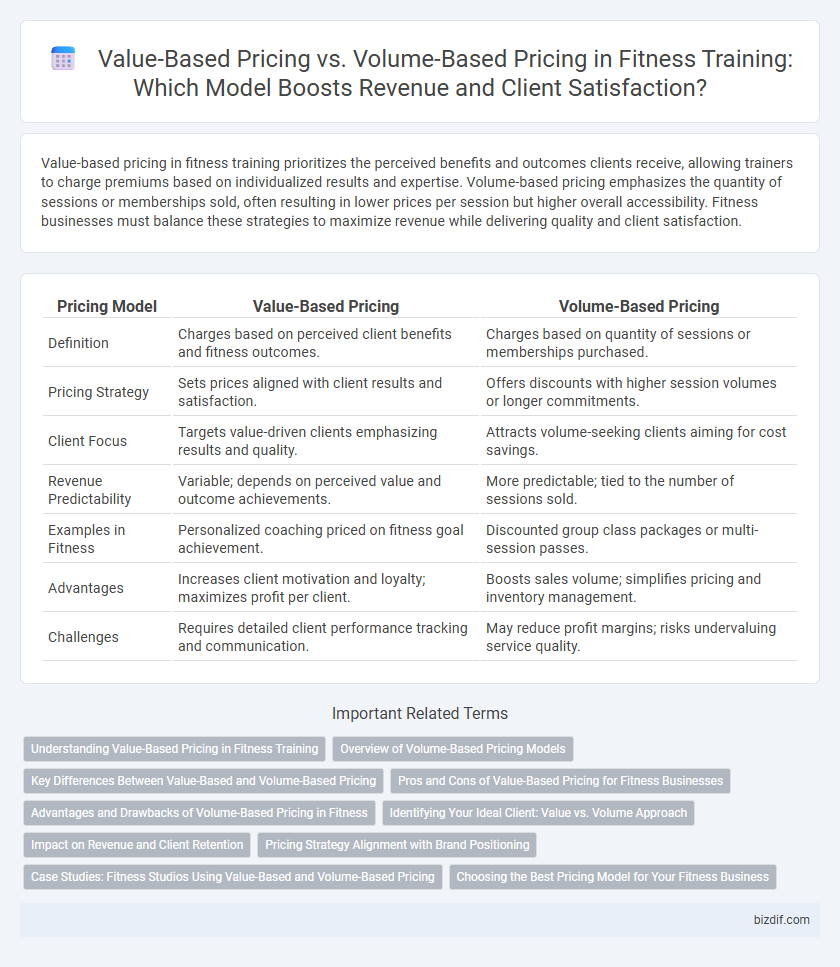Value-based pricing in fitness training prioritizes the perceived benefits and outcomes clients receive, allowing trainers to charge premiums based on individualized results and expertise. Volume-based pricing emphasizes the quantity of sessions or memberships sold, often resulting in lower prices per session but higher overall accessibility. Fitness businesses must balance these strategies to maximize revenue while delivering quality and client satisfaction.
Table of Comparison
| Pricing Model | Value-Based Pricing | Volume-Based Pricing |
|---|---|---|
| Definition | Charges based on perceived client benefits and fitness outcomes. | Charges based on quantity of sessions or memberships purchased. |
| Pricing Strategy | Sets prices aligned with client results and satisfaction. | Offers discounts with higher session volumes or longer commitments. |
| Client Focus | Targets value-driven clients emphasizing results and quality. | Attracts volume-seeking clients aiming for cost savings. |
| Revenue Predictability | Variable; depends on perceived value and outcome achievements. | More predictable; tied to the number of sessions sold. |
| Examples in Fitness | Personalized coaching priced on fitness goal achievement. | Discounted group class packages or multi-session passes. |
| Advantages | Increases client motivation and loyalty; maximizes profit per client. | Boosts sales volume; simplifies pricing and inventory management. |
| Challenges | Requires detailed client performance tracking and communication. | May reduce profit margins; risks undervaluing service quality. |
Understanding Value-Based Pricing in Fitness Training
Value-based pricing in fitness training centers on setting prices according to the perceived value and unique benefits clients derive from personalized workout plans, expert coaching, and measurable progress. This approach aligns pricing with client goals such as weight loss, muscle gain, or improved athletic performance, offering tailored programs that justify premium fees. Unlike volume-based pricing, which charges per session regardless of results, value-based pricing enhances client motivation and retention by emphasizing outcomes and individual transformation.
Overview of Volume-Based Pricing Models
Volume-based pricing models in fitness training often offer discounted rates as the quantity of sessions purchased increases, encouraging clients to commit to larger packages. These models prioritize client acquisition and retention by making bulk session purchases more affordable, fostering long-term engagement. Fitness centers leveraging volume-based pricing benefit from predictable revenue streams and reduced administrative costs associated with frequent individual transactions.
Key Differences Between Value-Based and Volume-Based Pricing
Value-based pricing in fitness training sets fees based on the perceived benefits and outcomes clients receive, reflecting personal transformation and improved health metrics. Volume-based pricing relies on the quantity of sessions or memberships sold, emphasizing the number of clients or class attendances regardless of individual results. Key differences include the focus on client value and satisfaction in value-based pricing, versus the emphasis on sales volume and scalability in volume-based pricing.
Pros and Cons of Value-Based Pricing for Fitness Businesses
Value-based pricing allows fitness businesses to charge clients based on the perceived benefits and results of training programs, enabling higher profits and stronger client loyalty. This pricing strategy can better reflect the quality of personalized fitness services, but it requires accurate assessment of client outcomes and may limit market reach by deterring price-sensitive customers. Implementing value-based pricing demands robust data on service effectiveness and clear communication to justify premium pricing, which can increase operational complexity for fitness providers.
Advantages and Drawbacks of Volume-Based Pricing in Fitness
Volume-based pricing in fitness training offers the advantage of attracting a larger client base by offering discounts for multiple sessions, which can improve cash flow and client retention. However, the drawback lies in potentially undervaluing personalized training, as uniform pricing may not account for individual session complexity or trainer expertise. This approach can lead to reduced profit margins and challenges in managing client expectations for quality and customization.
Identifying Your Ideal Client: Value vs. Volume Approach
Identifying your ideal client in fitness training involves understanding whether a value-based pricing or volume-based pricing model aligns with their needs and spending behavior. Clients seeking personalized, high-quality training experiences are better suited to value-based pricing, which emphasizes tailored services and premium outcomes. Those prioritizing affordability and frequent sessions usually respond well to volume-based pricing, focusing on cost efficiency through package deals or membership plans.
Impact on Revenue and Client Retention
Value-Based Pricing in fitness training maximizes revenue by aligning prices with perceived client benefits, encouraging higher investment from motivated clients and improving long-term retention through personalized value. Volume-Based Pricing attracts a broader customer base with lower per-session costs, increasing client acquisition but potentially reducing overall revenue per client and risking churn without tailored engagement. Combining both strategies strategically can optimize revenue streams while maintaining a loyal and growing client base.
Pricing Strategy Alignment with Brand Positioning
Value-based pricing in fitness training emphasizes aligning prices with the perceived benefits and results clients receive, reinforcing a premium brand image focused on personalized outcomes and expertise. Volume-based pricing targets mass markets by offering lower rates for higher enrollment, supporting a budget-friendly brand positioned for accessibility and scale. Choosing the right pricing strategy ensures consistent brand messaging and maximizes client acquisition aligned with long-term business goals.
Case Studies: Fitness Studios Using Value-Based and Volume-Based Pricing
Fitness studios leveraging value-based pricing report increased client retention and higher revenue per session by aligning prices with the perceived benefits and outcomes of personalized training programs. In contrast, volume-based pricing models in fitness centers often drive membership growth through discounted bulk packages but may result in lower profit margins and reduced individual client engagement. Case studies reveal that studios using value-based pricing gain competitive advantages by focusing on quality and customized services, while volume-based pricing suits high-traffic facilities aiming for scale.
Choosing the Best Pricing Model for Your Fitness Business
Choosing between value-based pricing and volume-based pricing impacts your fitness business's profitability and client satisfaction. Value-based pricing emphasizes the unique benefits and results your training programs deliver, allowing for premium rates aligned with client outcomes. In contrast, volume-based pricing focuses on attracting a larger client base through lower prices per session, optimizing revenue through scale rather than individual value.
Value-Based Pricing vs Volume-Based Pricing Infographic

 bizdif.com
bizdif.com